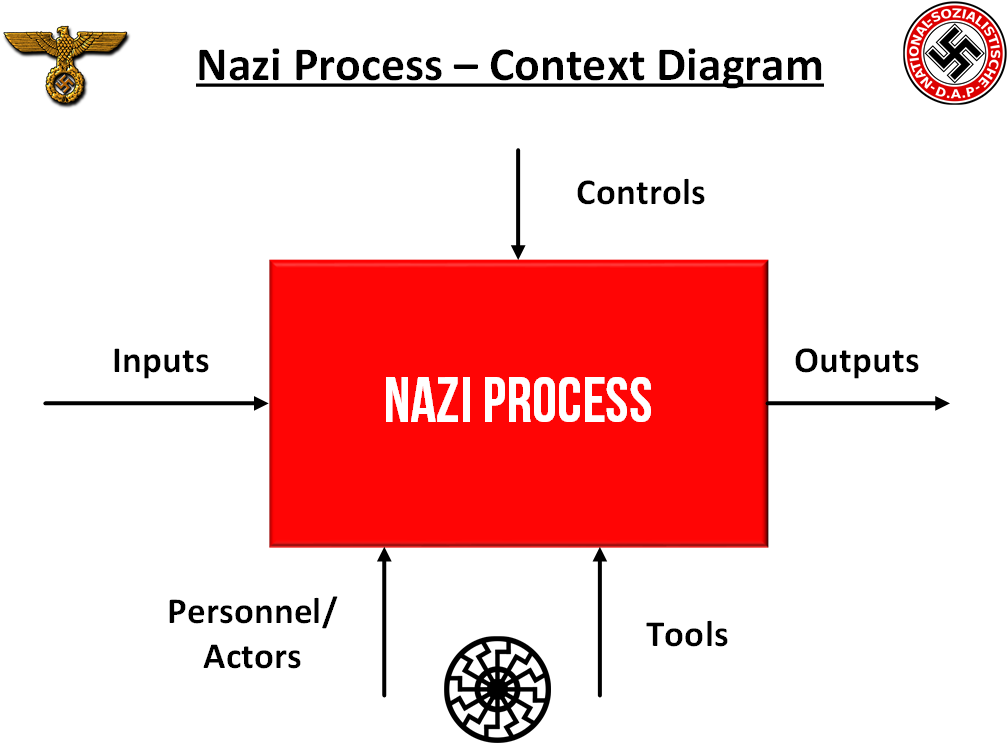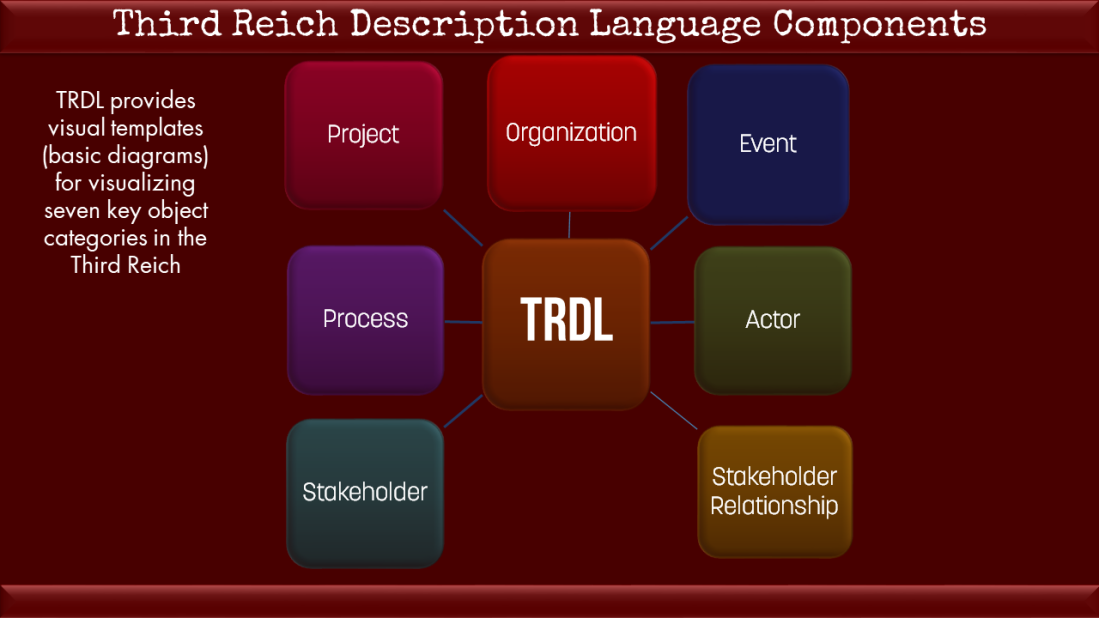
Category: TRDL
Key Visual Diagram for Nazi Germany and the Basic Book Structure (1)
 All complex systems are analyzed in top-down fashion (direction). In visual modeling, it means that we start with “painting the most general portrait” of the system in question (in this case, Nazi Germany).
All complex systems are analyzed in top-down fashion (direction). In visual modeling, it means that we start with “painting the most general portrait” of the system in question (in this case, Nazi Germany).
In systems analysis terms, by putting together the most general (“top level”) visual diagram for the whole Third Reich. You can find this diagram in Figure 2.
Some of its components (“objects”) we can – and will – describe and analyze right then and there (e.g. Nazi identity, mission of the Third Reich, etc.); for others we must develop their own diagrams (called decomposition diagrams in visual modeling).
And then repeat the same process for decomposition diagram until we develop a genuinely comprehensive and uniform portrait of Nazi Germany. And thus the whole genuinely comprehensive guide to the Third Reich.
Consequently, this book (The Essential Guide to Nazi Germany) will be structured around this comprehensive portrait of the Third Reich (essentially the comprehensive and uniform Essential Visual Guide to Nazi Germany).
I will cover in detail the complete structure (and logic) of this book in the next section; here I will only present its key components (components of the most general portrait of Nazi Germany that is). And, of course, explain why I chose these components for painting the general portrait of the Third Reich.
Every description (of every object, process, project, event, individual, etc.) will obviously begin with an executive summary. And Nazi Germany in general is no exception, of course.
As is the case with just about every system, everything that the Nazis did was determined by their identity. Their Nazi identity that I will cover in sufficient detail.
And I will prove beyond the reasonable doubt that every Nazi was not only a national socialist (although all of them were), but a national-sociopath. And will explain in detail what exactly it meant in practical terms.
Nazi Germany was a brainchild, a creation, a baby mostly of one individual – its Führer Adolf Hitler. Consequently, a large (a very large actually) chapter of this Guide will cover in detail the personality and biography of the founder and leader of the Nazi system.
However, Hitler was not the only founding father of Nazi Germany. The Third Reich was the product of several founding forces and the result of several founding events (including decisions and actions of about two dozen founding fathers). Therefore, I will devote one of the key chapters of The Guide to these forces, events and founding fathers.
Nazi Germany was essentially the incarnation (in flesh and blood, brick and mortar) of Nazi ideology (developed, of course, mostly by Adolf Hitler and heavily influenced by the abovementioned forces events and founding fathers).
Hence, one of the chapters in this book will cover in sufficient detail all key aspects of Nazi ideology. In both versions – the one developed by Adolf Hitler and the one that was the brainchild of SS Reichsfuhrer Heinrich Himmler (these were, indeed, different versions of Nazi ideology).
All systems (including organizational systems, of course) have but one fundamental objective – to satisfy the aggregate needs (not often illusory wants and desires, but genuine needs) of their stakeholders. Financial, functional, emotional and emotional needs, to be more precise.
Therefore, in the next section of the book, I will cover both internal (various social groups in the Nazi state) and external (Axis powers, neutral nations, the Church, adversaries, etc.) stakeholders of Nazi Germany. Including, obviously, the relationships between the Third Reich and its stakeholders.
Key Visual Diagram for Nazi Germany
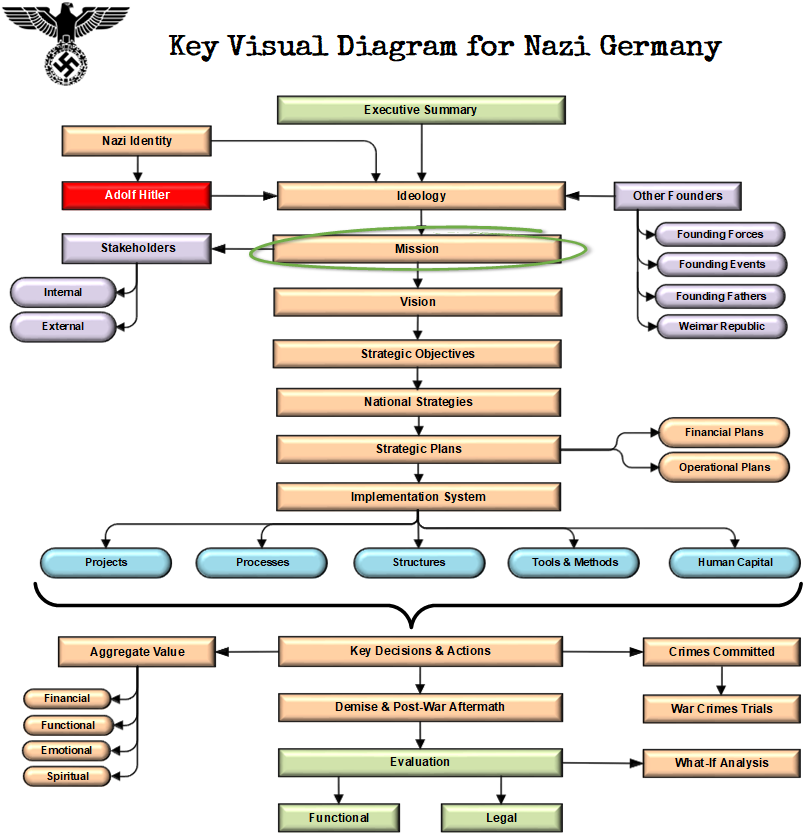
Systems Analysis Tools to Be Used in This Book
 Nazi Germany was a system. A huge, mammoth, gargantuan one, but still a system. Consequently, to develop a genuinely comprehensive and uniformly well-structured guide to Nazi Germany, we must use systems analysis tools.
Nazi Germany was a system. A huge, mammoth, gargantuan one, but still a system. Consequently, to develop a genuinely comprehensive and uniformly well-structured guide to Nazi Germany, we must use systems analysis tools.
Nazi Germany was an organization. An enormously large, incredibly complex, obviously criminal but still an organization. Consequently, to develop a genuinely comprehensive and uniformly well-structured guide to Nazi Germany, we must use organizational systems analysis tools.
As I have mentioned earlier, to perform a genuinely comprehensive analysis of Nazi Germany (there can be no comprehensive guide without a prior comprehensive analysis), we must visualize all key components of the Nazi organizational system (you can analyze only what you can see).
To visualize these components, we obviously need visual tools and technologies. Visual tools for organizational systems analysis, to be more precise. To put it simply, we need diagrams.
Actually, we need a small (but obviously sufficient) set of visual templates (basic diagrams) that we will use to develop a comprehensive picture (portrait, actually) of Nazi Germany. Organizational systems analysts call this portrait a visual model of the organizational system in question (in this case, the Third Reich).
As Nazi Germany was an organization, this set of visual templates (obviously) must be derived from the set of templates used for visualizing, describing and analyzing organizations (businesses, government entities, non-profits/NGOs, etc.).
I have developed such a set of basic templates (traditionally called a visual language by systems analysts). Not surprisingly, I called it an Organization Description Language (ODL for short).
Using this language as a starting point, I then developed a small but sufficient set of diagrams that I will use in this book to develop a genuinely comprehensive and uniformly structured portrait of Nazi Germany (and thus the genuinely comprehensive Guide to the Third Reich). Not surprisingly, I called this set of diagrams Third Reich Description Language (TRDL for short).
Description of TRDL is quite technical and this book was written for history buffs (i.e. amateur and professional historians, not systems analysts). Consequently, I provide the (reasonably) detailed TRDL description in the Appendices to this book.
In the main body of the book I will introduce TRDL diagrams when needed – and provide only the absolute minimum of technical details.
Need for the Right Tools & Technologies
 Nazi Germany was an absolutely unique and an incredibly complex system (probably, the most complex system in human history). It consisted of literally thousands and thousands components (objects, processes, projects, individuals, etc.) that interacted with each other and with their environment (internal and external stakeholders of Nazi Germany).
Nazi Germany was an absolutely unique and an incredibly complex system (probably, the most complex system in human history). It consisted of literally thousands and thousands components (objects, processes, projects, individuals, etc.) that interacted with each other and with their environment (internal and external stakeholders of Nazi Germany).
Obviously, to understand Nazi Germany, we must analyze (properly and in sufficient detail) all of its key components and their interactions. To make it possible, we must identify them, visualize them (you can analyze only what you can see) and structure them in the most natural, adequate and convenient way.
To make it happen, we obviously need the right methodology and the right tools (in other words, the right tools and technologies). Actually, the fundamental reason why the genuinely comprehensive guide to Nazi Germany has not yet been written is precisely the absence of such tools and technologies (and, obviously, the historians who know how to use them).
Now these tools and technologies (and the one who can and will very efficiently use them) have finally arrived.
Forces That Created Nazi Germany
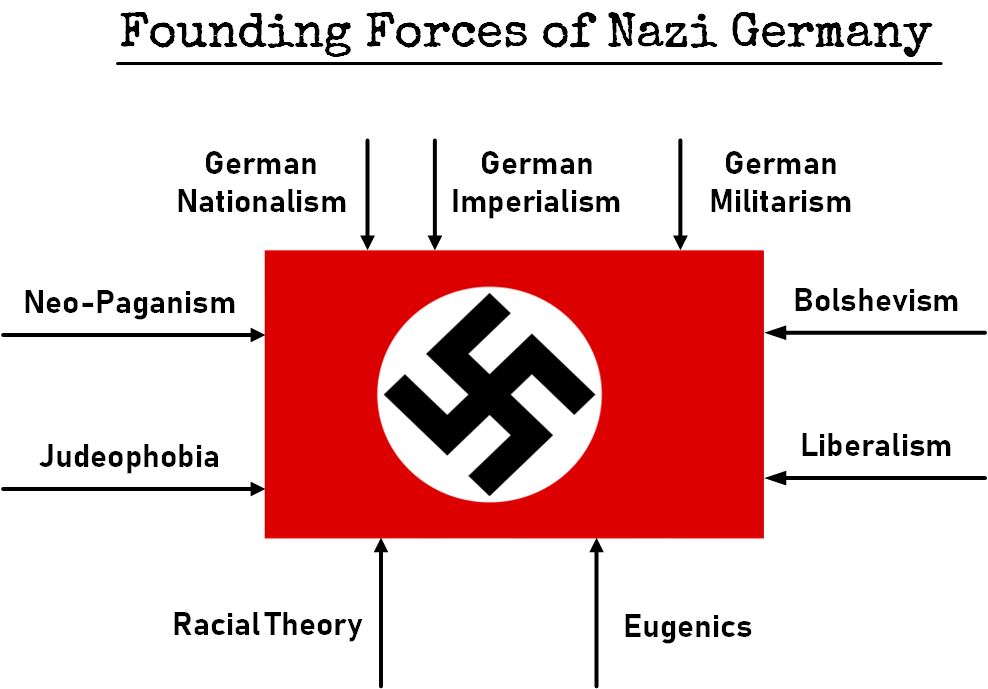
Nazi Germany Description Diagram – Level I
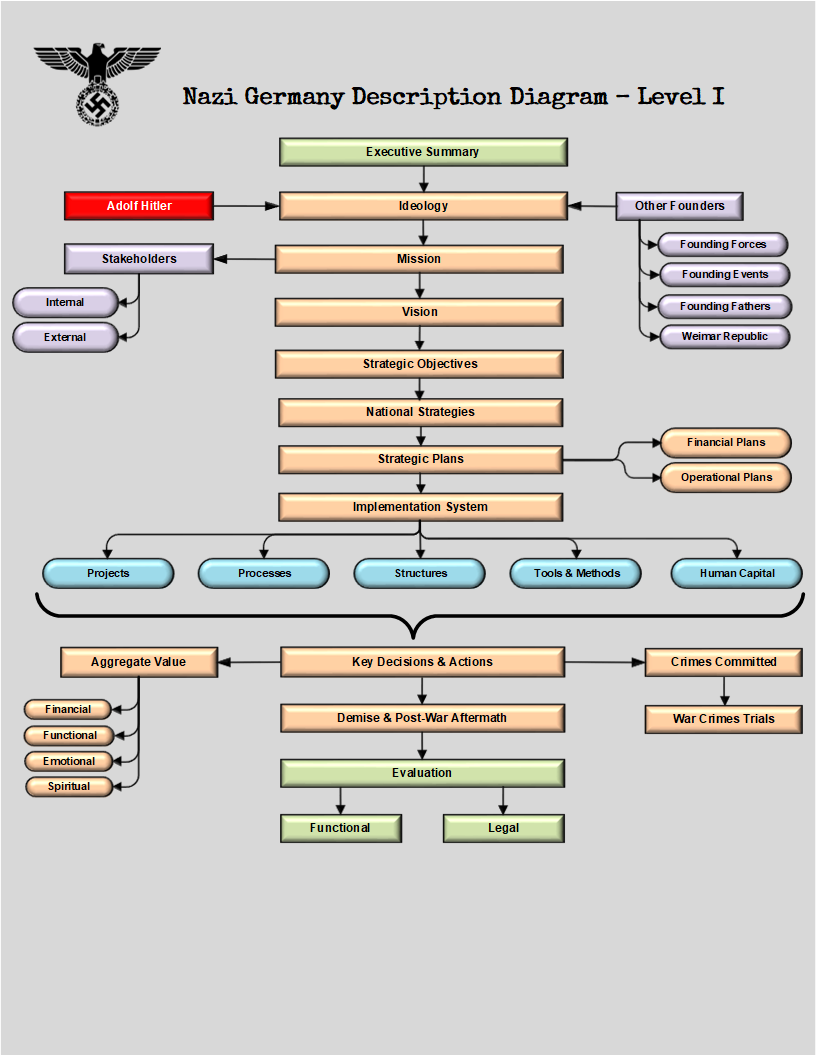
Nazi Shareholder Relationship Description Diagram
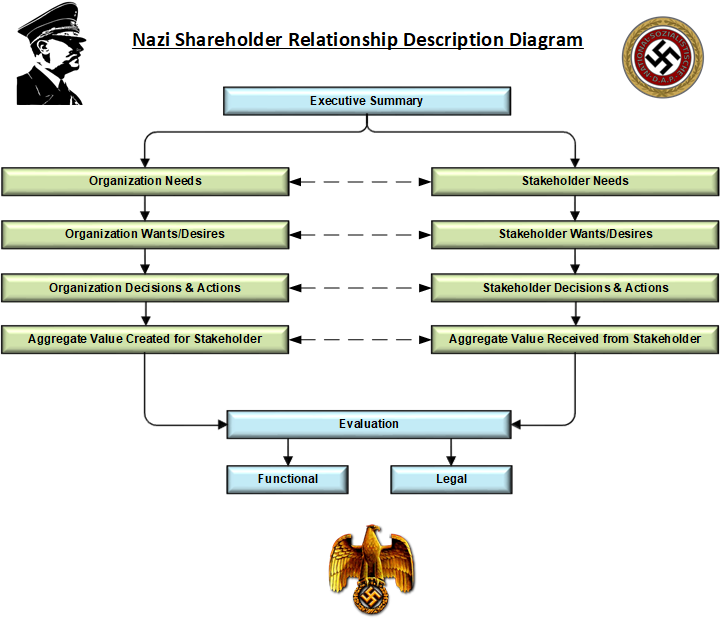
Nazi Process Description Diagram
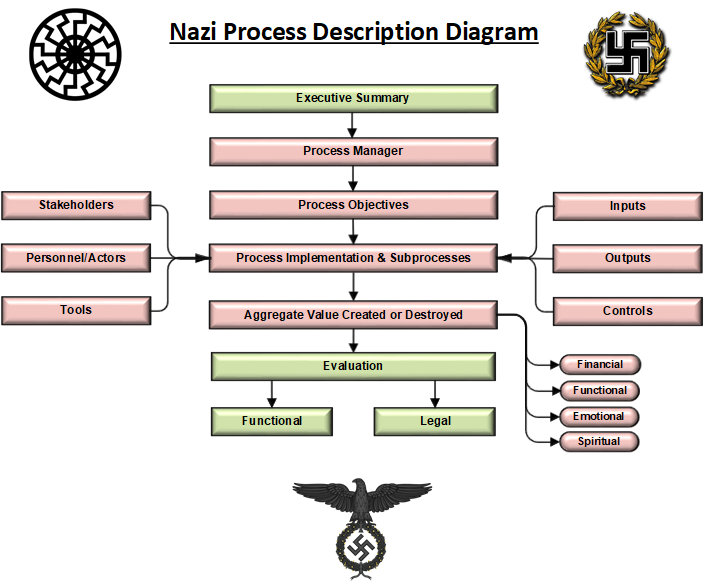
Nazi Process – Context Diagram
This is the IDEF0 context diagram (Level 0) that I will use to describe processes in Nazi organizations.
